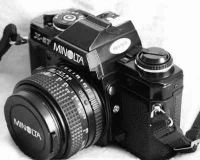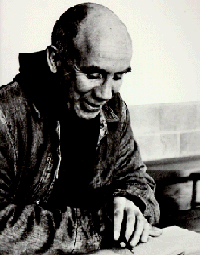
Minolta X-570 35mm SLR Camera
Well, just call me old-fashioned.
I stared out the 21st century by selling all my old Minolta 35mm equipment and going with a brand-new Olympus D450 digital camera, with a whopping 1.3 megapixel resolution, and a 3x optical zoom. I've used that for the past five years with no problems, other than the limitations imposed by a digital range-finder type camera. While the Olympus was easy to use, and took some very fine pictures, the loss of creativity as compared with my previous 35mm SLR's was too much too take.
The Olympus was a good "people" camera--if you just wanted to take pictures of your friends or relatives. But if you wanted to do any sort of nature photography, or action shooting, the Olympus was just not up to the task.
So now here in the middle of 2005, I find myself going back to 35mm SLR photography, and back to Minolta for cameras and lenses.
But I'm not buying a Minolta MAXXUM 35mm SLR with auto-focusing lenses....that would be too easy...rather I've aquired an old Minolta X-570 35mm SLR with manual focus technology (your hand turns a specially crafted focusing ring on the camera lens). Since Minolta doesn't make manual focus cameras anymore, I've been aquiring old Minlota equipment from family, friends and even eBay. I've also purchased an old Minolta SRT-101 35mm SLR, considered by many to be the best made 35mm camera of all-time. It features completely manual controls....you have to set the film speed, f-stop, shutter speed and focus the lens every time you take a picture. (Although film-speed usually needs to be set only once, when you initially load the camera with a roll of film.)
While I've currently accumulated an eclectic hodge-podge of lenses and accessories for the Minoltas, I've come up with a "core" group of lenses and accessories I would like to have for my main kit. The selection of lenses and accessories are designed to take advantage of the features of the X-570 camera in particular. Here's the list:
LENSES:
Minolta 28mm f2.8 wide-angle
Minolta 50mm f2.0 standard
Minolta 50mm f1.4 standard (for low-light situations)
Minolta 200mm f4.0 telephoto
Vivitar 500mm f8.0 telephoto-mirror lens with a dedicated 2X tele-converter
Minolta 35-70mm f3.5 zoom
Minolta 300-S 2X tele-converter
ACCESSORIES:
Minolta 280PX Flash Unit (designed especially for "X" series cameras)
Minolta Power Winder G autowinder
miscelaneous Hoya filters
With this simple assortment of lens and accessories, I can fullfill most of my photography needs. I might get a Minolta 135mm f2.8 telephoto as well, simply because it is a useful small telephoto with sharp optics.
My strategy is to use my Minolta and Vivitar teleconverters to "fill-in" those places where I need a telephoto lens of a particular focal-length. With the teleconverters, my available "lenses" are as follows:
1. 28mm f2.8 wide-angle
2. 50mm f2.0 standard
3. 50mm f1.4 standard (for low-light situations)
4. 100mm f4.0 tele-photo (50mm f2.0 with tele-converter)
5. 200mm f4.0 telephoto
6. 400mm f6.0 telephoto (200mm f4.0 with tele-converter)
7. 500mm f8.0 telephoto-mirror
8. 1000mm f10.0 telephoto-mirror (500mm with dedicated tele-converter)
9. 35-70mm f3.5 zoom
10. 70-140mm f5.5 tele-photo zoom (35-70mm with tele-converter)
As you can see, the tele-converters allows me the flexibility to have additional focal-lengths that I don't have to purchase. The 500mm Vivitar lens has a 10X magnification factor, but with it's dedicated teleconverter, it becomes a 1000mm 20x monster telephoto! 500mm and longer lenses are wonderful for nature photography, especially when taking pictures of birds and small mamals.
So why didn't I go with a digital SLR instead of going back to film? Simple: cost. While the new digital SLR's are wonders to behold, they are also very, very expensive, usually starting around $800 US for a camera and a lens, then going up from there.
Going back to film allows me to save lots of $$$ on equipment, especially when making use of eBay auctions! Here's a price comparison between a brand-new Konica-Minolta Maxxum 7D digital SLR and what I've been paying for the older equipment:
Konica-Minolta Maxxum 7D digital SLR with 28-100 AF zoom lens
$1,200.00 US - Amazon.com
Minolta SRT-101 with Kiron 28-85 zoom lens and a Minolta 50mm f1.4 standard lens
$42.00 US - eBay
You can buy and develop a LOT of film for the $1,100 in savings...a lot of film....plus the SRT-101 with it's lenes and proper film can easily out-perform the Maxxum 7D in the place where it matters most: quality images.
In case your wondering, the price I paid for the X-570 is $0. That's right, it was FREE! My father gave it to me after he decided to go with a Pentax *ist digital SLR.
But don't think one has to give up have digital images just because they own a 35mm film SLR. With an inexpensive flatbed scanner and/or film scanner, all those film pictures can easily be digitized, if need be.
The only big difference is do you want to fill up shoe-boxes with pictures and negatives, or fill up hard-drives and CD-ROM's?
But I haven't given up on digital entirely, as I also own a new Kodak D7590 5 mega-pixel digital camera with a 10X optical zoom. For just random picture taking, the $350 US (Walmart.com) D7590 is a decent camera. But my old Minoltas still kick it's butt in terms of image quality.
Photo of Minolta X-570 from the MinMan website, dedicated to Minolta manual focus cameras and equipment.


